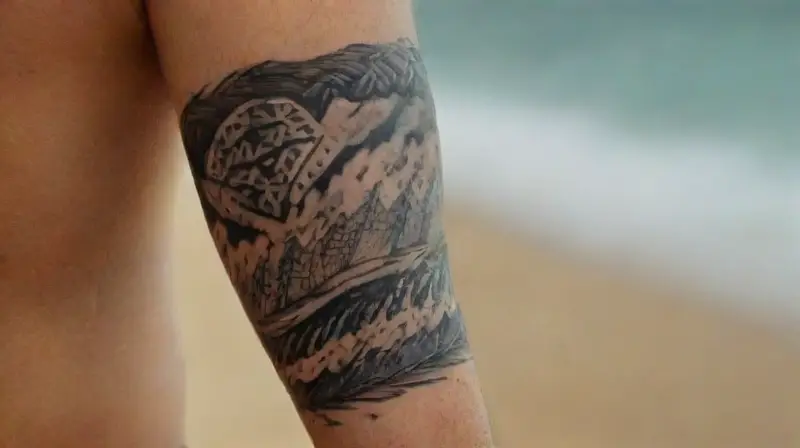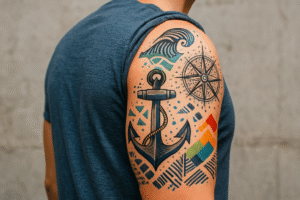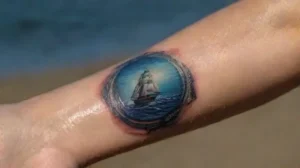Polynesian tattoos hold a profound cultural significance that extends beyond mere decoration. These intricate designs serve as a form of identity and storytelling, uniquely tailored to each individual’s life journey and social status. Traditionally, these tattoos are deeply embedded in Polynesian heritage, symbolizing personal achievements, spiritual beliefs, and connections to ancestors.
Throughout history, Polynesian mariners relied heavily on their tattoos to convey important messages. These markings not only identified their tribal affiliations but also offered protection during voyages across vast and treacherous oceans. The art of Polynesian marking is an enduring tradition that continues to thrive today, reflecting a rich cultural tapestry passed down through generations.
Origins of Polynesian Maritime Tattoos
The origins of Polynesian maritime tattoos can be traced back thousands of years to ancient seafaring communities. Early Polynesians developed these tattoos as a means of asserting status and demonstrating prowess as explorers and fishermen. The designs often featured motifs inspired by the ocean, such as waves, fish, and navigational symbols.
These tattoos were typically applied over months or even years, requiring patience and skill. They served as a visual language, encoding essential information about a person’s achievements, rank, and ancestral lineage. This tattooing tradition was also believed to invoke protection from the gods during dangerous ocean voyages.
Furthermore, these markings played a vital role in rites of passage, such as reaching adulthood or completing a significant expedition. The act of tattooing itself was a sacred ritual, often performed with ceremonial ceremonies that reinforced communal bonds and spiritual protection.
Significance of Marine Motifs
Marine motifs are central to Polynesian tattoo designs, reflecting the significance of the ocean in everyday life. Waves, turtles, sharks, and fish are commonly depicted, each carrying symbolic meanings of strength, resilience, and guidance. These images serve as a reminder of humanity’s harmonious relationship with nature.
These motifs also acted as symbols of navigation, representing the skills of oceanic explorers who charted new islands and routes. The designs often contain symbols believed to grant safe passage and protection from sea dangers. In this way, tattoos functioned as both artistically beautiful and spiritually protective.
Designs were personalized to reflect the individual’s maritime experiences. For instance, a sailor’s tattoo might include a first catch or a significant voyage, serving as a memorial of their seafaring milestones. Such motifs fostered a sense of identity rooted in their seafaring heritage.
Tattooing Techniques and Tools

Traditional Polynesian tattooing techniques are impressive feats of craftsmanship. Artisans, known as tattooists, used tools made from bone, shell, or sharpened stone to create precise and lasting designs. The process was often painful but regarded as a sacred spiritual act.
The application involved tapping or pounding inked tools into the skin using a comb-like device or other percussion methods. This technique allowed for the creation of detailed and durable patterns that could last a lifetime. The ink was typically made from natural ingredients like soot, crushed coral, or plant dyes.
The experience of tattooing was considered a rite of passage and a communal event. It often involved family and community elders who supervised and guided the recipient through the process. The physical rituals underscored the tattoos’ importance as markers of cultural identity and spiritual significance.
Symbolism of Facial and Upper Body Tattoos
In many Polynesian cultures, facial and upper body tattoos hold particular esteem and are reserved for specific social statuses or roles. These tattoos often feature complex patterns that signify a person’s achievements, ancestry, or spiritual protection.
For example, a prominent facial tattoo might indicate leadership or warrior status within the community. The designs are carefully placed to enhance the natural features and convey a sense of authority and dignity. Such tattoos are often a lifelong commitment and regarded as sacred.
The process of obtaining these facial tattoos is highly ritualistic, involving prayers and ceremonies that reinforce their spiritual meaning. They serve not only as personal markers but also as symbols of community identity and cultural pride.
Modern Interpretations and Revivals

In contemporary times, Polynesian maritime tattoo traditions experience both revival and adaptation. Many people embrace these tattoos to celebrate their Polynesian heritage and maintain cultural connections across generations. Artists around the world are learning traditional techniques to preserve the authentic style.
However, modern tattoo enthusiasts often incorporate personal elements or motifs inspired by Polynesian art, blending tradition with individual expression. This fusion sometimes raises discussions about cultural appropriation, emphasizing the need for respect and understanding of the original meanings.
Despite these evolutions, efforts are being made within Polynesian communities to protect the authenticity of their tattoo heritage. Cultural leaders are promoting education and workshops to ensure that the deep significance behind these designs is honored and preserved for future generations.
Ethical Considerations and Cultural Respect
Respecting Polynesian traditions is crucial when engaging with maritime tattoo art. Many designs carry sacred meanings and are considered intellectual property of specific tribes or communities. Using such symbols without permission can be seen as cultural appropriation and disrespectful.
It is important for those interested in Polynesian tattoos to seek guidance from cultural experts or artists knowledgeable about the symbolism and history. Doing so helps honor the craftsmanship and spiritual significance embedded in the designs. Engaging authentically fosters appreciation rather than cultural exploitation.
By understanding the cultural context, enthusiasts can approach Polynesian maritime tattoos with greater respect and sensitivity. Supporting authentic artists and respecting the traditions behind these symbols ensures that this sacred art form continues to thrive honorably.
Conclusion
Polynesian maritime tattoos are more than just decorative designs; they are powerful symbols of identity, history, and spiritual beliefs. Each pattern tells a story—of personal milestones, divine protection, and a reverence for the ocean that sustains their way of life. Their rich symbolism connects individuals to their ancestors and the broader Polynesian community.
Today, these tattoos serve as a bridge between past and present, embodying cultural resilience and pride. As they gain popularity worldwide, it is essential to honor their origins and significance. Respectful engagement and understanding are key to preserving the integrity of this ancient art form for future generations.





